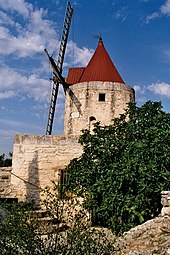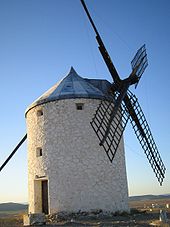Tower windmill




A tower windmill ( ndl. Torenmolen , engl. Tower (wind) mill , French. Moulin tour ) is a windmill with a cylindrical, tower-like mill house made of stone and a fixed cap (later with a rotating hood), as it was in the 13th and 14th centuries was built on castle walls ( Hammerstein Castle ), fortifications and ramparts ( Zons , Cologne ( Bottmühle , Ulrepforte, etc.), Wijk bij Duurstede near Utrecht , Netherlands ). On the Lower Rhine, these fortress mills , which are more common there, are also called bears (mills) because of their compact design .
description
The wing cross or wheel or the cap - these are usually flat, conical - are firmly attached to the mill tower and cannot be rotated horizontally, so they cannot be rotated in a different wind direction and had to be aligned with the main wind direction at the start of construction. In Europe, this type has been known since the 14th century, mainly in the region around the Mediterranean ( Spain , Greece , southern France, etc.) as its own type (so-called "Mediterranean type") with country-specific wing construction. This can be a wing cross according to the Western European pattern (e.g. sail gate wing) or a windmill construction of four, six or eight rod rods arranged to form a wheel, connected at the ends with a surrounding wire and with up to twelve or more triangular sails attached to the rod ends (see page with Cretan tower windmill in the German Museum). This type of windmill is also called "sailing windmill" after the winged cross. The transmission of the power into the mill interior was initially carried out by simple gears , later also by means of a comb wheel and vertical shafts .
Further development
Tower mills of the so-called Dutch design were a further development in Central and Western Europe (Holland, Germany, France , England , Ireland ), Denmark , Sweden , and occasionally in Poland, the Czech Republic, Slovakia and Hungary, often at ground level or on a hill - like a Erd- or Bergholländer, who have a cap that can often be rotated from the inside (inner mixer , ndl. Binnenkruier ). This is the older turning method for cap mills, the codend tracking was only developed in the 16th century. They have a cylindrical, sometimes slightly conical, stone-walled, tall and slender or massive and squat-looking mill house - the mill tower. It originated in the 15th century. An example is the “Steprath Mill” in Geldern - Walbeck , a cylindrical tower windmill with codend tracking. It is the oldest functioning windmill in Germany, dating from the 15th century. In the east of Germany there is mainly the low, mostly cylindrical, compact-looking tower windmill type with a max. three floors, often with onion or bell dome and compass rose control, but also high tower mills like the one in Pahrenz, Hirschstein municipality . The Pantaleons- or Neumühle ( Lohmühle ) based on the Bachtor the city walls in Cologne was built (1730-1860) was 35 meters tower height (39 m incl. Conical cap with Steertkrühwerk), the highest in the world (1880 burned, demolished 1883) .
In the mill country of the Netherlands, only cylindrical stone mills are called torenmolens , the conical ones (in Holland, often 25 m and higher in cities) - depending on the design - ronde stenen stellingmolens ("round stone gallery mills " (gallery Dutch)), ronde stenen bergmolens ("round Stein-Bergholländermühlen ") or ronde stenen grondzeilers (" Runder Stein- Grundsegler "(Erdholländermühlen)). You always have an external harvester with a reel and codend or, more rarely, a wind rose. Among them are the world's tallest windmills De Nolet (43 m cap height, built in 2006; power generator, not a "real" mill) and De Noord (built 1807; 33.5 m) in Schiedam , Zuid-Holland .
distribution
In the west of North Rhine-Westphalia there are many such mills ( Immerather Mühle near Erkelenz , Kevelaerer Mühle, Niederembter Mühle ( Bergheim ), Oberaußemer Mühle (Bergheim), Egelsberger and Elfrather Mühle, in the Minden-Lübbecke mill district, etc.), but most of them apart Function. In eastern Germany they were mainly built in Saxony, Saxony-Anhalt, Thuringia, and also in Hungary , Poland and the Czech Republic (e.g. the "Old Windmill Kuželov" southeast of Brno near the border with Slovakia with a conical mill tower, a tower Erddolländer).
In the Netherlands there are still four functioning (cylindrical) tower windmills as grain mills, three as internal turner in the province of Gelderland in the places Lienden (De Zwaan, 1644), Zeddam (Grafelijke Torenmolen, 1441) and Zevenaar (de Buitenmolen, 1408 or 1450) and a fourth in Maastricht- Gronsveld (van Gronsveld, 1618–1623). It is designed as an external turner (with external rake - cod and reel, ndl. Buitenkruier ) and the most southerly windmill in the Netherlands.
In France, especially in the south (Aquitaine), west (Loire region), north and in central France there are still a number of preserved tower windmills (French: moulin à tour, moulin tour [à vent]): z. B. "Moulin Alphonse Daudet ", Fontvieille , Alpillen , near Arles ; "Moulin de Bélard", St.-Lys, Haute-Garonne department . We can speak of three types of tower windmills:
- Widespread in France: the typical tower windmill with a cylindrical tower made of natural stone, in some areas also slightly conical and up to six stories high, cap rotatable with an often steep conical roof (in the south ( Provence , Languedoc-Roussillon etc.) only up to or in front of the Roof reaching the edge of the wall (wall ring) and generally with a dormer-like roof over the wing outlet .
- in Flanders ( Nord-Pas-de-Calais ): similar to the Dutch stone windmills with a slim, conical stone structure, as gallery , earth and wall windmills.
- in Brittany and on the Atlantic coast of the Loire region, in addition to the classic French tower windmills, there are windmills with a significantly larger upper floor opposite the substructure (“large heads” (French “large-têtes”) or “small feet” (French “petit-pieds”) )
This type of mill is not a rare sight in England. Examples can be found all over England such as the tower windmills "Stembridge" (the only thatched tower mill in England) and "Ashton" in Somerset , " Chesterton " (worldwide unique arcade tower mill with an arcade rondel as the bottom floor) in Warwickshire and others. v. m. In Ireland the two tower windmills in Skerries ( Co. Fingal ) are very well known, both rotated from the outside with five or four blades. However, there, as in Germany, any type of stone windmill (see above), whether slim and conical (Steingalerieholländermühle) or compact and cylindrical ("real" tower windmills), is called tower mills or tower windmills. Particularly striking are the slim, conical Lincolnshire mills, mostly painted black with bitumen to protect against moisture, with four, five and six blades. As such, the six-story tower gallery dutch mill from 1830 in Heckington, North Kesteven , Lincolnshire , is famous, the world's only windmill of this type with eight (!) Louvre blades. On the British Channel Island of Jersey, a tower windmill from 1837 with four blades has been preserved in the parish of Saint Peter .
literature
- Dietrich Lohrmann : Tower windmills and wind cars in the 14th-15th centuries Century. Comments on two unedited engineering manuscripts . In: Technikgeschichte, Vol. 67 (2000), H. 1, pp. 25-40.
Web links
- Fédération Des Moulins de France
- Cretan tower windmill in the German Museum
- Website of Germany's oldest functioning windmill, the "Steprather Mühle"
- Mill photos from England
- French (tower) windmills
- Mill database of the University of Kent with b / w images
- French windmill page with many photos
Individual evidence
- ↑ Die Kappenmühle ( Memento from July 14, 2014 in the Internet Archive ) (PDF; 722 kB)
- ↑ Acrylic picture of the Pantaleon mill

